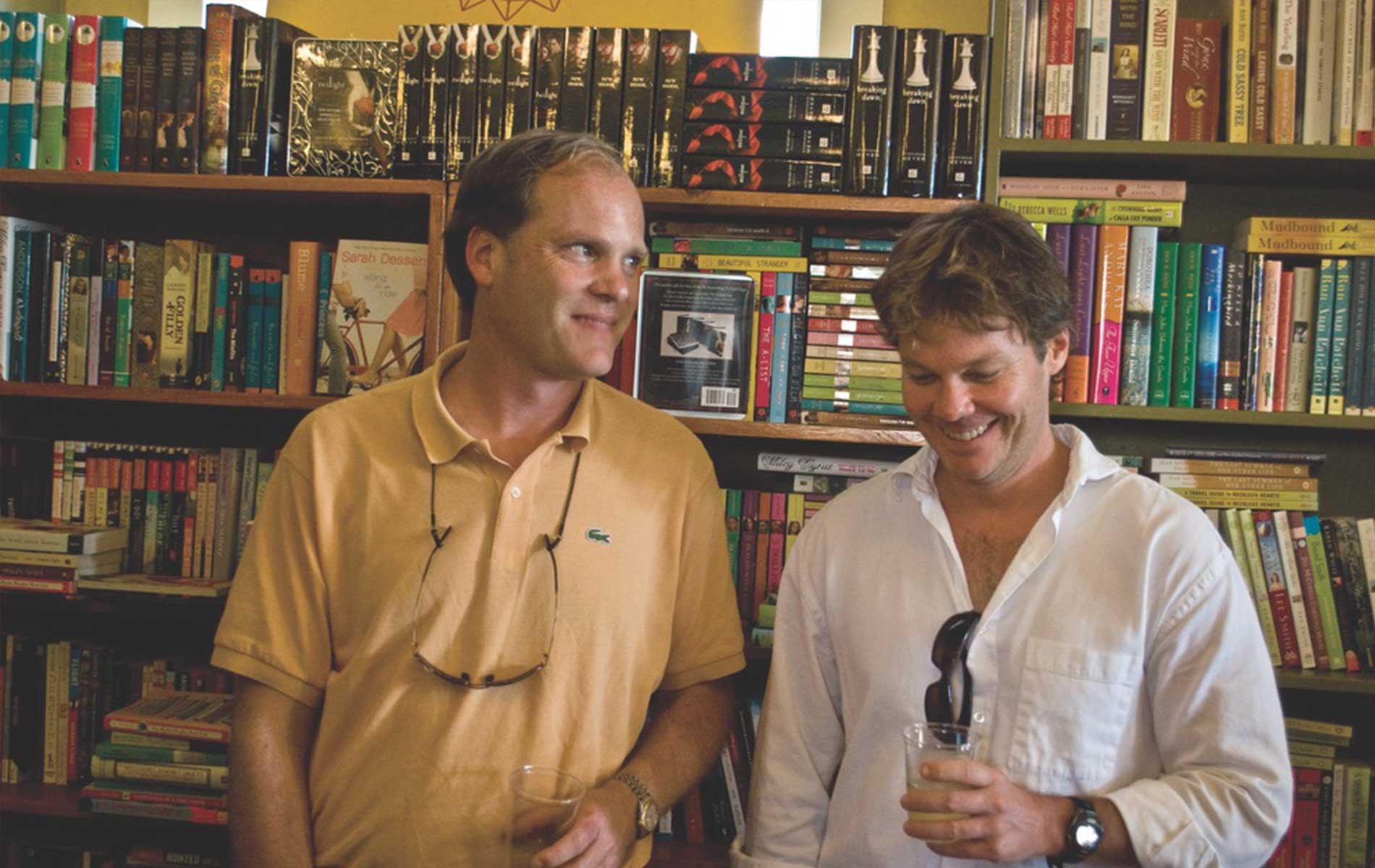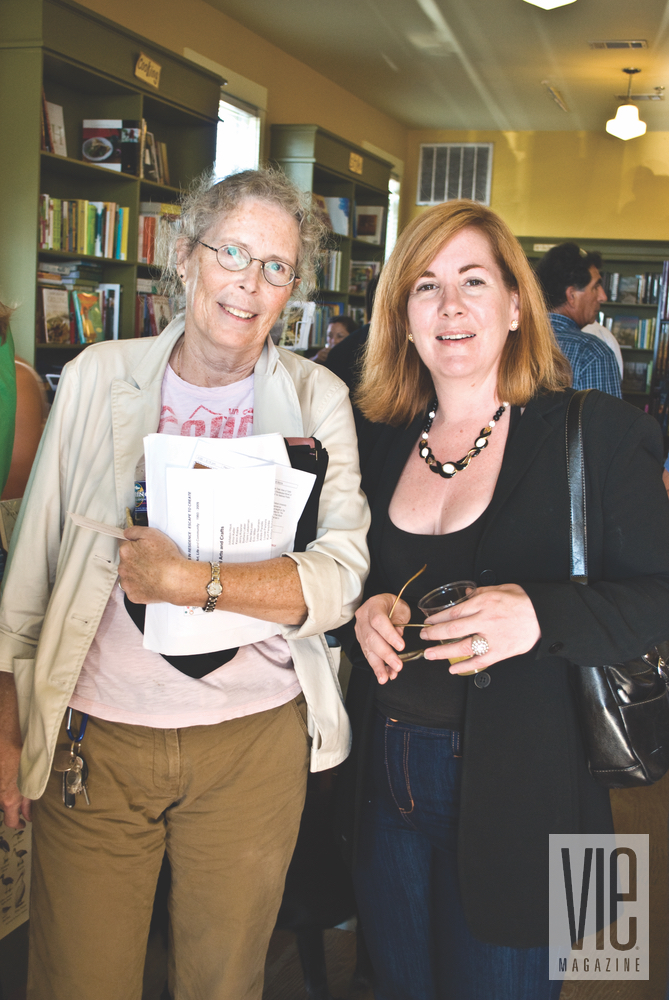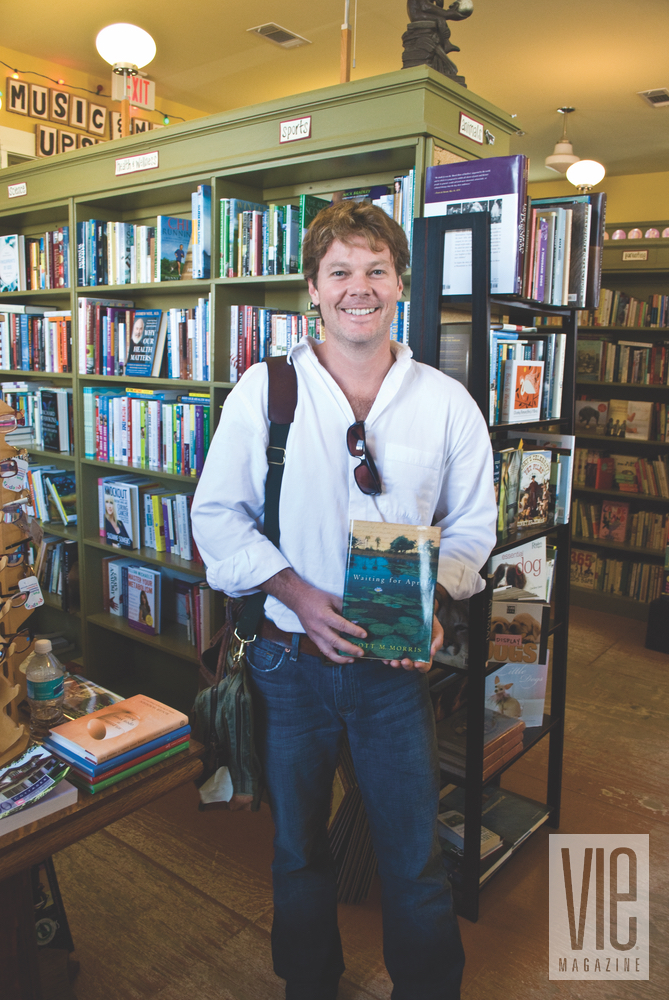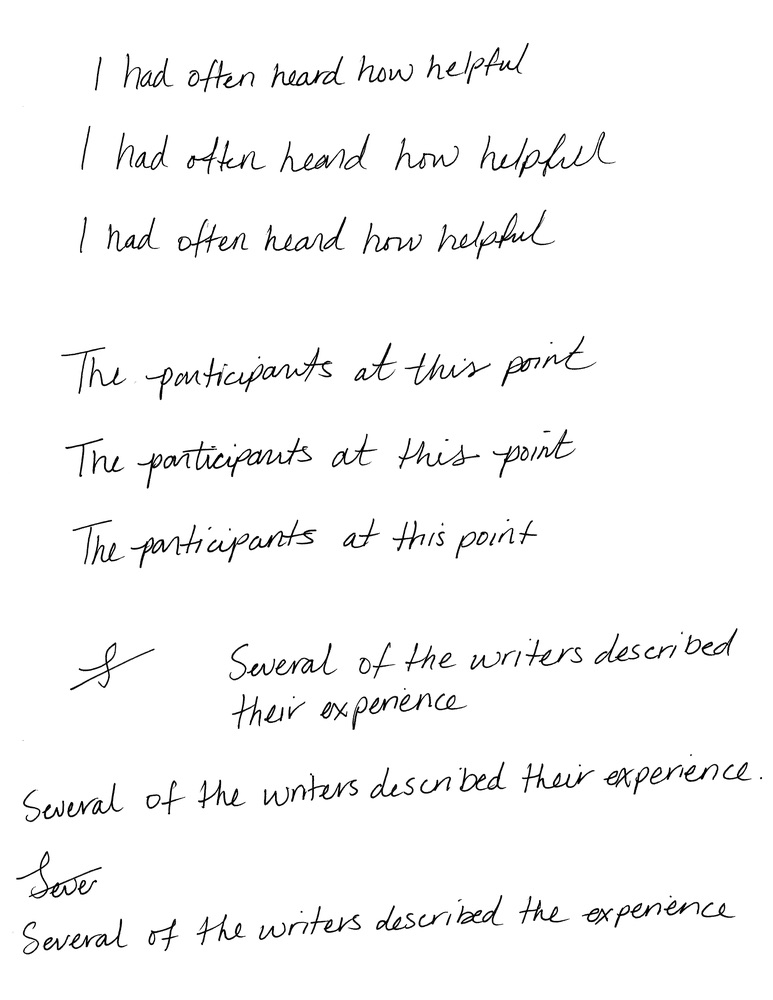
vie-magazine-hero-writers-conference
Down to the Sea with Paper, Pen, and Time
Learning to Write at Escape to Create’s Fall Writers Conference at Seaside
By Prudence Farrow Bruns | Photography by Lisa Ferrick
I realize I am a snob when it comes to art and literature. My background in the arts has set high standards for me. Having traveled widely, and having lived and worked in such places as Manhattan, London, San Francisco, and Los Angeles, I have been exposed to some of the world’s best writers and their works. So, when my husband and I had the opportunity to attend a writers conference at Seaside October 14 to 16, my expectations were high. I had often heard how helpful writers conferences can be for a writer, and since I am writing my first novel, I was game to try this one. I confess, I was hoping for the best from the conference, but not expecting it. Much to my surprise, it met my highest expectations.
The conference began and ended in the warm welcoming atmosphere of Sundog Books, which provided wine and music. We then moved over to the Great Southern Café for tasty hors d’oeuvres, where we were joined by Robert and Daryl Davis, the founders of Seaside. Our mornings consisted of a delicious continental breakfast catered by Amavida in Seaside. The second round of luscious hors d’oeuvres took place on our second evening, this time at Bud & Alley’s Pizza Bar, where conversation stimulated by the day’s activities continued. While we enjoyed the sunset on the beautiful beaches, Dave Rauschkolb, the owner of Bud & Alley’s and its Pizza Bar, joined us. After reaching our fill of good food and good conversation, many of us extended our evening by attending an excellent production of Harold Pinter’s The Homecoming by The Seaside Repertory Theatre players. Fortunately, throughout the conference, the weather was perfect. Even an early downpour during the first evening of the conference proved to be soft and welcoming.
Our meetings were held on the second floor of the Seaside home of Marsha and David Dowler. The large room in which we met faced east and was bright, spacious, and airy due to the many tall, open windows surrounding the room. Most of the participants were local; although my husband and I knew many of them from before, we did not know about this side of them. Among the participants were other writers, photographers, a poet, several lawyers, at least two architects, and two teachers from South Walton High School. All in all, there were about twenty-five participants. Each person attending was fascinating and contributed many sensitive and perceptive questions. Several of the conference’s featured writers mentioned how they had never experienced a group as savvy as this one.

Prudence Bruns and poetess Erin Belieu
The conference writers were a wide assortment: a poet, a novelist, two nonfiction writers, a playwright, and a singer-songwriter. From the start of the first session, I found myself glued to my seat as I listened to each writer describe insights into his or her own individual writing process. The presentations began with adept explanations of the ins and outs of the writers’ individual crafts. Inevitably, upon interaction with this very astute group of participants, each session evolved into an intimate telling, almost a confession at times, of the writer’s own personal experiences. The conference reached its critical point toward the end of the workshop. All six presenters were seated before us. The participants, at this point, had become more of a kind of collective entity rather than a disparate group. The intimacy in the room was palpable.
The discussion revolved around feelings and their role in the life of a writer. David Magee, a nonfiction writer, described how the process of writing had brought him to his knees, so to speak. He said that, with each progressive work, he had grown as an individual by constantly asking more from himself while delving deeper and deeper into the characters about whom he was writing. As a result, writing was actually becoming more and more difficult for him, and he didn’t know how much more he had to give. He described this experience as being extremely painful. Another writer in the group quickly cited a quote: “With each novel, I die a little…” Melanie Hammet, the singer-songwriter, described her process of writing as like that of a relationship or a discourse with herself. “Isn’t it all a matter of perspective?” Neil White asked rhetorically, presenting the idea that people throughout the world suffer from much worse conditions, such as starvation and disease, than the pain of writing. He advised that we need to maintain perspective.
The poet, Erin Belieu, broke in, suggesting that, perhaps, “perspective” is difficult to maintain since a writer spends so much time alone, which naturally results in a disproportionate obsession with oneself. The conversation continued in this manner until, suddenly, a single voice broke from our collective group, crying out, “Is this group therapy?” We all laughed a little uneasily. I was to later ask David Magee about his mounting pain. He said it was a beautiful pain because he felt alive in ways he had never felt before. He said that writing was “addictive to the point of no going back.”
Much of what we learned, as with all good art, could be applied to one’s own life. Words such as “patience,” “honesty,” “understanding,” “listening,” and “enjoying” were continually reiterated. The memoir writer, Neil White, author of In the Sanctuary of Outcasts (Morrow/HarperCollins), stressed the need for brutal honesty with oneself. By admitting what is most terrifying to acknowledge, one scourges oneself of self-righteousness. He said that writing a memoir involves a self-search for meaning. Questions that should be asked are Why are you writing? and Why is it important? There must be emotional accuracy.

Author Scott Morris
David Magee, who is an award-winning columnist and non-fiction writer, having most recently published The Education of Mr. Mayfield, described all good writing as a form of self-help. He said that it is not so much an expression of your heart as of your soul. He also stressed that less is always more when it comes to writing. The conviction of the story must be allowed to breathe. A good writer must have the courage to take away what is not necessary. Both David and Neil emphasized the need for including details when writing. The author must not be tempted by generalities or universals, but rather must use the details to build the story. Neil said that one should not tell a scene, but “show” it, allow readers to visualize it.
The playwright Rich Orloff, who is best known for Funny as a Crutch, described how he used comedy to portray a serious subject. He emphasized honesty. A playwright should not try to show the importance of a scene, but rather bring believability to it, not so much through good dialogue as through an accurate or honest understanding of what lies behind or beneath the scene. He also emphasized the need to give oneself plenty of time. At first, I was amazed by this last point; however, in one way or another, all of the writers stressed it. They explained that a lot of what most people might consider “procrastination” is a necessary part of the “creative” process. They also accentuated the need to get the writing out, in any way possible—just get it out. The first stage of writing should be understood as embryonic; it is where the piece of writing is frail and in need of protection. Neil warned us to never apply a critical eye while writing the first draft; that will come later. He cautioned us against showing our work to anyone too early in the process. He, David, and Scott advised developing a coterie of trusted friends to look at our work in its later stages. But always, they insisted, the writer must remain true to him or herself.
Rich Orloff described the development of a play as a journey; he said that it is more than writing a plot and a story line. He demonstrated and highlighted many of his salient points by having us watch several of his short plays performed by the Seaside Rep players at the Seaside Rep Theatre. It was interesting to hear him describe the vital role that an audience plays in shaping and developing a play. Rich described how readings before audiences were a critical part of honing a play. He explained that, based upon the audience response, he is able to understand the tenor of his play and whether or not it is working. He said that readings of his plays before audiences allow him to get it right.
Several of the writers described their experience with writing as being the same as falling in love. All of them were passionate about it and said that they were willing to give up whatever was required in order for them to continue writing. The poet, Erin Belieu, explained that a poem is not a puzzle to be figured out, but rather a written piece to be enjoyed on a visceral level through its sound, rhythm, and feeling. “Poems are snippets of life,” she said. “We don’t always understand the significance or meaning of our lives.” Erin believes that all people have poems inside of them. She also emphasized how poetry never becomes outdated. There are all kinds of poetry for all kinds of people. She read to us “I Heart Your Dog’s Head,” which is from her recent collection of poems, Black Box. It is a hilarious poem based on her distaste for football and one particular NFL coach, Bill Parcells. We laughed until our stomachs hurt.
The fiction writer, Scott Morris, who is the author of Waiting for April, appeared more introverted than the other writers, for he rarely spoke while the others were constantly vying for the floor. When I asked him why he became a writer, he replied that he did so because he was a reader. He loves good prose, and he stressed that, in good prose, style is a natural part of the story. When it came time for Scott’s presentation, he very appropriately read his most recent short story rather than discussing his craft. Needless to say, his prose is lovely and speaks more eloquently than any explanation he could have presented. The architect sitting next to me described it as the most beautiful writing she had ever encountered. Scott’s story was an extremely moving account of his observations of a mentally challenged student in middle school. There were very few dry eyes in our group by the time he stopped reading.
All of the presenters agreed that being a writer requires a lot of introspection, which helps one see oneself more clearly, making one a better person. Melanie Hammet, the singer-songwriter, used the word “synesthesia” to describe the interconnectivity of sensory experiences and how stimulation of one of the senses leads to automatic experiences in a second sense. She demonstrated this principle by singing a song about urban planning and development, inherently a dry subject, which she brought to life through the sound and rhythm of her music and the poetics of her words. She explained how art is not exercised in a vacuum. She also described how she uses her songs as therapy to break through to the often hidden feelings of grieving children, ages seven through twelve, when nothing else will. By making a song out of the children’s own associations with words such as “sad,” “mad,” etc., she is able to help them express painful feelings that they have been unable to share with others.

I must give my sincere thanks to Seaside’s Escape to Create for sponsoring the conference. Escape to Create, Seaside’s artist-in-residency program, has recently expanded to provide “cultural, educational and artistic events for the entire South Walton community throughout the year.” I have admired, over the last seventeen years or so, the high level of integrity of this program. Until recently, its sole purpose was to support artistic ventures by bringing artists of all types to Seaside for one month to “escape” the confines of everyday life and to “create.” Most of the writers speaking at the conference had been participants of its program. When I spoke to Melanie, she stated that the support provided by the program had been “phenomenal” and a “life changer” for her, expressing how there are few places in the world in which one could find donors coming together to provide artists one full month in which to create.
The snob in me has been humbled. With all of the joy and benefit that I have gained from attending this conference, the most important thing that I took away from it is a clearer insight into creativity. Creativity is contagious. Even though much of the creative process may be solitary, the experience acquired by being with other creative people seems to be equally necessary. Scott Morris emphasized how he was inspired to learn to write by reading the good writing of others. The conference showed me that when creative people come together, they share their “creativity,” resulting in enhanced creative endeavors. With Escape to Create expanding its focus into South Walton, we can look forward to further artistic possibilities for our community.
— V —
Prudence Farrow Bruns is an accomplished producer of television, plays, and film, including the 1994 feature film Widow’s Peak starring Mia Farrow. She holds a Ph.D. in South Asian Studies – Sanskrit from University of California at Berkeley and has held teaching positions at Berkeley and at Rutgers University. Prudence lives in Seagrove Beach with her husband, Albert, and is currently working on her first novel. For more information on Prudence, please visit her website www.prudencefbruns.com.
Share This Story!
KEEP UP WITH THE LATEST STORIES FROM VIE
















































































































































